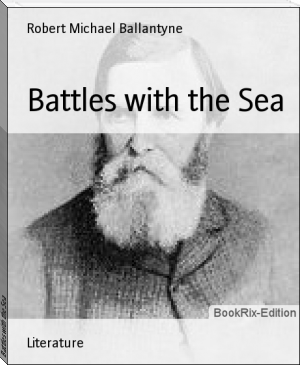Battles with the Sea by Robert Michael Ballantyne (top 100 books of all time checklist txt) 📖

- Author: Robert Michael Ballantyne
Book online «Battles with the Sea by Robert Michael Ballantyne (top 100 books of all time checklist txt) 📖». Author Robert Michael Ballantyne
The _buoyancy_, therefore, of a lifeboat is not affected for more than a few seconds by the tons of water which occasionally and frequently break into her. To prove this, let me refer you again to the account of the Constance, given by its gallant coxswain, as recorded in the third chapter. He speaks of the lifeboat being "buried," "sunk" by the wave that burst over the bow of the Stanley, and "immediately," he adds, "the men made a grasp for the spare oars!" There is no such remark as "when we recovered ourselves," etcetera. The sinking and leaping to the surface were evidently the work of a few seconds; and this is indeed the case, for when the force that sinks a lifeboat is removed, she rises that instant to the surface like a cork, and when she tumbles over she recovers herself with the agility of an acrobat!
The transporting-carriage is a most essential part of a lifeboat establishment, because wrecks frequently take place at some distance from a station, and prompt assistance is of the utmost importance in all cases of rescue. It is drawn by horses, and, with its exceedingly broad and strong wheels, can be dragged over any kind of road or across soft sand. It is always backed into the surf so deep that the boat may be launched from it, with her crew seated, and the oars out, ready to pull with might and main the instant the plunge is made. These first strokes of a lifeboat's crew are of immense importance. Want of union or energy on the part of steersman or crew at this critical point may be fatal. The boat must be made to cut the breakers end-on, so as to prevent her turning broadside on and being rolled back on the beach. Even after these initial strokes have been made successfully, there still remains the possibility of an unusually monstrous wave hurling the boat back end over end.
The boat resting on its carriage on the sands (Figure 1) shows the relative position of the two. It will be seen, from that position, that a very slight tip will suffice to cause the bow of the boat to drop towards the sea. As its keel rests on rollers, comparatively little force is required to launch it. Such force is applied by means of ropes attached to the stern, passing through pulleys at the outer end of the carriage, so that people on shore haul the ropes inland in order to force the boat off its carriage seaward.
Once the boat has got fairly over the surf and out upon the wild sea, her progress is comparatively safe, simple tugging against wind and sea being all that has to be done until the wreck is reached, where dangers of another kind await her.
I have now shown that the great qualities of our lifeboat are--_buoyancy_, or a tendency not to sink; _self-righting_ power, or inability to remain upside down; _self-emptying_ power, or a capacity to discharge any water that may get into it; and _stability_, or a tendency not to upset. The last quality I shall refer to, though by no means the least, is _strength_.
From what has been already written about lifeboats being hurled against wrecks and rocks, it must be evident that the strength of ordinary boats would not suffice.
In order to give them the requisite strength of frame for their tremendous warfare, they are built of the best Honduras mahogany, on what is known as the diagonal plan--that is, the boat has two distinct "skins" of planking, one set of planks being laid on in a diagonal position to the others. Moreover, these planks run from one gunwale round under the boat to the other gunwale, and have a complete layer of prepared canvas between them. Thus great strength and elasticity are combined, so that the boat can stand an inconceivable amount of battering on wreckage, rocks, or sand, without being destroyed.
That this is really so I will endeavour to prove by referring in the next chapter to a particular instance in which the great strength of one of our lifeboats was powerfully illustrated.
It may be added, in conclusion, that the oars of a lifeboat are short, and so made as to combine the greatest possible strength with lightness. They are fastened to the gunwale by short pieces of rope, and work in a moveable iron crutch on an iron thole-pin. Each boat is provided with a set of spare oars. Her equipment of compass, cables, grapnels, anchors, etcetera, is, as may be supposed, very complete, and she rides upon the storm in a rather gay dress of red, white, and blue, in order that she may be readily distinguished from other boats--her lower parts being white, her upper sides blue, and her line of "fender" all round being scarlet.
CHAPTER FIVE.
MORE TALES OF HEROISM.
If any one should doubt the fact that a lifeboat is _all but_ indestructible, let that sceptical one read the following tale of wreck and rescue.
On a terrible night in the year 1857 a Portuguese brig struck on the Goodwin Sands, not far from the lightship that marks the northern extremity of those fatal shoals. A shot was fired, and a rocket sent up by the lightship. No second signal was needed. The Ramsgate men were, as usual, keeping a bright lookout. Instantly they jumped into the lifeboat, which lay calmly floating in the harbour alongside the pier. So eager were the men to engage in the deadly struggle that the boat was over-manned, and the last two who jumped in were obliged to go ashore again.
The tug _Aid_ was all ready--according to custom--with steam up. She took the boat in tow and made for the mouth of the harbour. Staggering out in the teeth of tide and tempest they ploughed their way through a heavy cross sea, that swept again and again over them, until they reached the edge of the Goodwins. Here the steamer cast off the boat, and waited for her while she dashed into the surf, and bore the brunt of the battle alone.
It was a familiar proceeding to all concerned. Many a time before had the Ramsgate boat and steamer rescued men and women and little ones from the jaws of death on the Goodwins, but they were about to experience a few novelties that night.
It was very dark, so that the boat had much difficulty in finding the brig. On coming within about eighty yards of her they cast anchor and veered down under her lee. At first they were in hopes of getting the vessel off, and some hours were spent in vain attempts to do this, but the gale increased in fury; the brig began to break up. She rolled from side to side, and the yards swung wildly in the air. A blow from one of these yards would have stove the boat in, so the Portuguese crew--twelve men and a boy--were taken from the wreck, and the lifeboat-men endeavoured to push off.
All this time the boat had been floating in a basin worked in the sand by the motion of the wreck; but the tide had been falling, and when they tried to pull up to their anchor the boat struck heavily on the edge of this basin. They worked to get off the shoals with the energy of men who believe that their lives depend on their efforts. For a moment they succeeded in getting afloat, but again struck and remained fast.
Meanwhile the brig was lifted by each wave, that came rushing over the shoals like a mountain chain of snow, and let fall with a thundering crash. Her timbers began to snap like pipe-stems, and, as she worked nearer and nearer to the boat, the wildly-swaying yards threatened immediate destruction. The heavy seas flew continually over the lifeboat, so that passengers and crew could do nothing but hold on to the thwarts for their lives. At last the brig came so near that there was a stir among the men; they were preparing for the last struggle-- some of them intending to leap into the rigging of the wreck and take their chance. But the coxswain shouted, "Stick to the boat, boys, stick to the boat!" and the men obeyed.
At that moment the boat lifted a little on the surf and grounded again. New hope was inspired by this. They pulled at the cable and shoved might and main with the oars. They succeeded in getting out of immediate danger, but still could not pull up to their anchor in the teeth of wind and tide. The coxswain then saw plainly that there was but one resource left--to cut the cable and drive away to leeward right across the Goodwin Sands, which at that place were two miles wide. But there was not yet sufficient water on the sands even for the attempting of that forlorn hope. As far as could be seen in that direction, ay, and far beyond the power of vision, there was nothing but a chaos of wild, tumultuous, whirling foam, without sufficient depth to float them over, so they held on, intending to wait till the tide, which had turned, should rise. Very soon, however, the anchor began to drag. This compelled them to hoist sail, cut the cable sooner than they had intended, and attempt to beat to windward--off the sands. It was in vain. A moment more, and they struck with tremendous force. A breaker came rolling towards them, filled the boat, caught her up like a plaything on its crest, and, hurling her a few yards onwards, let her fall with a shock that well-nigh tore every man out of her. Each successive breaker treated her in this way!
Those who dwell by the seashore know well those familiar ripples that mark the sands when the tide is out. On the Goodwins those ripples are gigantic banks, to be measured by feet, not by inches. I can speak from personal experience, having once visited the Goodwins and walked among the sand-banks at low water. From one to another of these banks this splendid boat was thrown. Each roaring surf caught it by the bow or stern, and, whirling it right round, sent it crashing on the next ledge. The Portuguese sailors gave up all hope and clung to the thwarts in silent despair, but the crew did not lose heart altogether. They knew the boat well, had often gone out to battle in her, and hoped that they might yet be saved, if they could only escape striking on the pieces of old wreck with which the sands were strewn.
Thus, literally, yard by yard, with a succession of shocks, that would have knocked any ordinary boat to pieces, did that lifeboat drive, during two hours, over two miles of the Goodwin Sands!
A thrilling and graphic account of this wreck and rescue is given in the Reverend John Gilmore's book, "Storm Warriors," in which he tells us that while this exciting work was going on, the _Aid_ lay head to wind, steaming half power, and holding her own against the storm, waiting for her lifeboat, but no lifeboat returned to her, and her gallant captain became more and more anxious as
 Have you ever thought about what fiction is? Probably, such a question may seem surprising: and so everything is clear. Every person throughout his life has to repeatedly create the works he needs for specific purposes - statements, autobiographies, dictations - using not gypsum or clay, not musical notes, not paints, but just a word. At the same time, almost every person will be very surprised if he is told that he thereby created a work of fiction, which is very different from visual art, music and sculpture making. However, everyone understands that a student's essay or dictation is fundamentally different from novels, short stories, news that are created by professional writers. In the works of professionals there is the most important difference - excogitation. But, oddly enough, in a school literature course, you don’t realize the full power of fiction. So using our website in your free time discover fiction for yourself.
Have you ever thought about what fiction is? Probably, such a question may seem surprising: and so everything is clear. Every person throughout his life has to repeatedly create the works he needs for specific purposes - statements, autobiographies, dictations - using not gypsum or clay, not musical notes, not paints, but just a word. At the same time, almost every person will be very surprised if he is told that he thereby created a work of fiction, which is very different from visual art, music and sculpture making. However, everyone understands that a student's essay or dictation is fundamentally different from novels, short stories, news that are created by professional writers. In the works of professionals there is the most important difference - excogitation. But, oddly enough, in a school literature course, you don’t realize the full power of fiction. So using our website in your free time discover fiction for yourself. 




Comments (0)